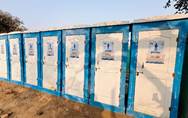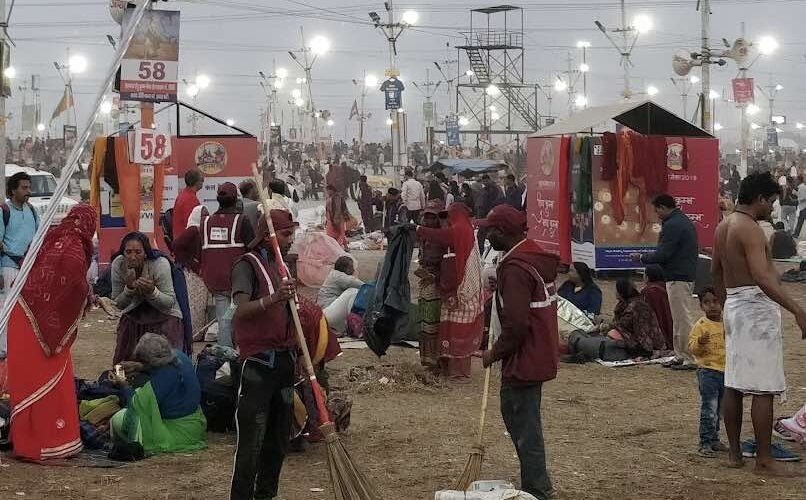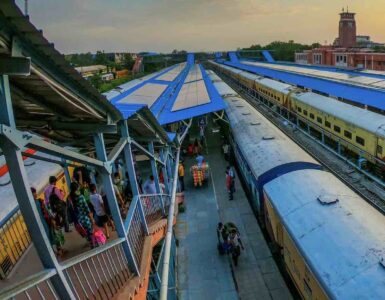On 13th January 2025, the world witnessed the commencement of the Maha Kumbh 2025, the world’s largest human gathering of faith and spirituality, where devotion meets celebration on an unparalleled scale.
The 45-day-long spiritual and cultural celebration in Prayagraj in Uttar Pradesh brings devotees, pilgrims and spiritual seekers from nooks and corners of India and worldwide.
On each day of the Maha Kumbh festival, thousands of devotees gather at the Sangam, the confluence of the Ganga, Yamuna, and Saraswati rivers to partake in the holy dip, considered sacred.
Over 15 million devotees took the holy dip on the first day, signalling an auspicious beginning to the Maha Kumbh. The following day celebrated as ‘Makar Sankranti’ brought around 35 million devotees to the Sangam.
These two days signal that this year’s Kumbh will have a record-breaking congregation. The anticipated turnout for Maha Kumbh 2025 is expected to be 400 million, surpassing several nations’ populations.
To manage the event is a monumental task, the Uttar Pradesh government has made meticulous arrangements for the Maha Kumbh, with the well-organized infrastructure to manage the massive influx of visitors.
Authorities have set up 160 thousand tents with essential facilities, including electricity, water, and sanitation. Many of these tents come with multiple beds offered to pilgrims for free or nominal charges.
To ensure the safety and well-being of the pilgrims, tourists and foreign visitors, the administration deployed over 50,000 security personnel, including police, paramilitary forces, and local security staff.
The Maha Kumbh will also feature various cultural programmes, with artists and devotees from different states presenting traditional dances and music, reflecting India’s cultural diversity.
The administration has provided amenities such as free medical services, drinking water, and transportation to ensure a comfortable experience for all attendees.
Special arrangements, such as affordable ration and cylinder distribution, secure bathing ghats, and bonfire provisions, ensure the comfort of visitors. Multiple health centres and hospitals are set up within the festival area to address health concerns.
Loudspeakers installed along the ghats continuously broadcast announcements, facilitating the swift reunion of separated individuals. Security forces stationed at the venue worked tirelessly to assist attendees, ensuring the event remained serene and well-organized.
There are Lost and Found centres to locate missing individuals, enhancing the safety and convenience of participants. There are camps to reunite separated families amidst the sea of humanity. These camps include dedicated sections for women and children, ensuring peace of mind for devotees who are lost in the massive crowd.
Cleanliness at MahaKumbh 2025
As anyone can imagine, one of the biggest tasks for the authorities would be maintaining sanitation, hygiene, and cleanliness at Mahakumbh. Given the ecological connection of the festival, the challenge is even more.
The sacred river Ganga is ecologically significant as it sustains diverse ecosystems, such as wetlands and floodplains, crucial for biodiversity, plants and wildlife, including the endangered Ganga River dolphin and various species of fish and birds.
As millions gather along the Ganga riverbanks for the Kumbh Mela, there will be spikes in waste like flowers, plastic, and other non-biodegradable materials.
In 2014, the Government of India launched the Clean Ganga Mission, formally known as the Namami Gange Programme, a comprehensive initiative to rejuvenate and restore the health of the Ganga River.
Under the National Clean Ganga Mission, the government has extended the initiatives to ensure cleanliness at MahaKumbh.
Special cleanliness management measures are being implemented for Rs. 152.37 crore (~US$ 17 million) at the Kumbh festival. These initiatives combine modern technology with traditional practices to ensure a clean and sustainable environment for the event.
Maintaining the purity of the Ganga, effective waste management, and creating plastic-free zones are top priorities for the Mahakumbh organization. The event is presented as a benchmark for environmental responsibility, emphasising cleanliness throughout the fair area.

Over 28,000 toilets, including 12,000 Fiber Reinforced Plastic (FRP) toilets equipped with septic tanks and 16,100 prefabricated steel toilets with soak pits have been installed across the fairgrounds.
These toilets aim to promote an eco-friendly approach while ensuring cleanliness.
Additionally, 20,000 community urinals have been set up to ensure a comfortable and hygienic experience for devotees while promoting eco-friendly practices.
To ensure effective waste management in the event area, 20,000 trash bins have been installed to help segregate waste at the source and to encourage reuse and recycling. To further streamline waste collection and disposal, 3.775 million liner bags have been provided.
This well-organized waste management system will keep the event area clean and eco-friendly. The strategies adopted for Mahakumbh 2025 will not only set high standards for cleanliness but also demonstrate the country’s commitment to environmental sustainability.
It is not just the government, even private companies like FMCG brand Reckitt through its flagship hygiene brand Dettol will support nearly 15,000 sanitation workers by providing training programmes and making soaps accessible to them at Kumbh.
The sanitation workers are working round the clock to ensure the entire region remains clean for devotees, coming to Prayagraj to attend the Maha Kumbh.
Additionally, ‘Ganga Seva Doots’ (Ganga service volunteers) are stationed at the bathing areas to maintain cleanliness at Mahakumbh. The volunteers promptly remove flowers and any other materials from the river, which are offered by the devotees during the holy dip.
Mahakumbh 2025 is not just a religious event but a model example of environmental conservation and cleanliness. It highlights the efforts of the government towards maintaining the purity of the Ganga, sustainable waste management, and creating plastic-free zones.
Through the main event, awareness about cleanliness and environmental protection is also planned at the Green Mahakumbh to be held on 31st January 2025.
As part of the Green Mahakumbh, discussions on issues related to nature, the environment, water and cleanliness are planned. Experts will share their insights and experiences on maintaining the balance of the five elements of nature and addressing the challenges they face.
The environmental initiatives and cleanliness at Mahakumbh will inspire not only the present generation but also future ones.






Add comment